Antibody data
- Antibody Data
- Antigen structure
- References [57]
- Comments [0]
- Validations
- Immunocytochemistry [4]
- Immunohistochemistry [1]
- Other assay [22]
Submit
Validation data
Reference
Comment
Report error
- Product number
- 36-4600 - Provider product page

- Provider
- Invitrogen Antibodies
- Product name
- Connexin 36 Polyclonal Antibody
- Antibody type
- Polyclonal
- Antigen
- Synthetic peptide
- Description
- This antibody reacts with mouse Connexin 36. On western blots, it identifies a single band at ~36 kDa. The specificity of this antibody was demonstrated using Connexin 36 knockout mice. Reactivity has been confirmed with mouse Connexin 36 transfected HeLa cell lysates, mouse brain, retina and pancreas homogenates.
- Reactivity
- Human, Mouse
- Host
- Rabbit
- Isotype
- IgG
- Vial size
- 100 μg
- Concentration
- 0.25 mg/mL
- Storage
- -20°C
Submitted references The disconnect2 mutation disrupts the tjp1b gene that is required for electrical synapse formation.
Functional connexin35 increased in the myopic chicken retina.
Increased Connexin36 Phosphorylation in AII Amacrine Cell Coupling of the Mouse Myopic Retina.
Effects of Constitutive and Acute Connexin 36 Deficiency on Brain-Wide Susceptibility to PTZ-Induced Neuronal Hyperactivity.
Phosphorylation of Connexin36 near the C-terminus switches binding affinities for PDZ-domain and 14-3-3 proteins in vitro.
Neuronal Glutamatergic Network Electrically Wired with Silent But Activatable Gap Junctions.
Rod Photoreceptors Signal Fast Changes in Daylight Levels Using a Cx36-Independent Retinal Pathway in Mouse.
Gap Junctions in A8 Amacrine Cells Are Made of Connexin36 but Are Differently Regulated Than Gap Junctions in AII Amacrine Cells.
Downregulation of Neuronal and Dendritic Connexin36-Made Electrical Synapses Without Glutamatergic Axon Terminals in Spinal Anterior Horn Cells From the Early Stage of Amyotrophic Lateral Sclerosis.
Differential Distribution of Retinal Ca(2+)/Calmodulin-Dependent Kinase II (CaMKII) Isoforms Indicates CaMKII-β and -δ as Specific Elements of Electrical Synapses Made of Connexin36 (Cx36).
Asymmetry of an Intracellular Scaffold at Vertebrate Electrical Synapses.
A genetic basis for molecular asymmetry at vertebrate electrical synapses.
Structural organization of the dendritic reticulum linked by gap junctions in layer 4 of the visual cortex.
Gap Junctions Contribute to the Regulation of Walking-Like Activity in the Adult Mudpuppy (Necturus Maculatus).
Low Level Pro-inflammatory Cytokines Decrease Connexin36 Gap Junction Coupling in Mouse and Human Islets through Nitric Oxide-mediated Protein Kinase Cδ.
Gain-of-function nature of Cav1.4 L-type calcium channels alters firing properties of mouse retinal ganglion cells.
Connexin36 expression in major centers of the auditory system in the CNS of mouse and rat: Evidence for neurons forming purely electrical synapses and morphologically mixed synapses.
Rapid reverse genetic screening using CRISPR in zebrafish.
Neurobeachin is required postsynaptically for electrical and chemical synapse formation.
Reciprocal regulation of epileptiform neuronal oscillations and electrical synapses in the rat hippocampus.
Abundance of gap junctions at glutamatergic mixed synapses in adult Mosquitofish spinal cord neurons.
Connexin36 in gap junctions forming electrical synapses between motoneurons in sexually dimorphic motor nuclei in spinal cord of rat and mouse.
Re-evaluation of connexins associated with motoneurons in rodent spinal cord, sexually dimorphic motor nuclei and trigeminal motor nucleus.
Connexin36 identified at morphologically mixed chemical/electrical synapses on trigeminal motoneurons and at primary afferent terminals on spinal cord neurons in adult mouse and rat.
Functional alterations in gut contractility after connexin36 ablation and evidence for gap junctions forming electrical synapses between nitrergic enteric neurons.
Molecular and functional asymmetry at a vertebrate electrical synapse.
Morphologically mixed chemical-electrical synapses formed by primary afferents in rodent vestibular nuclei as revealed by immunofluorescence detection of connexin36 and vesicular glutamate transporter-1.
The rod pathway of the microbat retina has bistratified rod bipolar cells and tristratified AII amacrine cells.
Blocking of connexin-mediated communication promotes neuroprotection during acute degeneration induced by mechanical trauma.
Mixed Electrical-Chemical Synapses in Adult Rat Hippocampus are Primarily Glutamatergic and Coupled by Connexin-36.
Synergy between electrical coupling and membrane properties promotes strong synchronization of neurons of the mesencephalic trigeminal nucleus.
Under construction: building the macromolecular superstructure and signaling components of an electrical synapse.
Cx36 is a target of Beta2/NeuroD1, which associates with prenatal differentiation of insulin-producing β cells.
Behavioral alterations and changes in Ca/calmodulin kinase II levels in the striatum of connexin36 deficient mice.
Trafficking of gap junction channels at a vertebrate electrical synapse in vivo.
Pituitary adenylate cyclase-activating peptide enhances electrical coupling in the mouse adrenal medulla.
Distribution of the neuronal gap junction protein Connexin36 in the spinal cord enlargements of developing and adult opossums, Monodelphis domestica.
Expression of connexin genes in the human retina.
Reorganization of gap junctions after focused ultrasound blood-brain barrier opening in the rat brain.
Network architecture of gap junction-coupled neuronal linkage in the striatum.
Connexin36, an essential element in the rod pathway, is highly expressed in the essentially rodless retina of Gallus gallus.
Connexin45-containing neuronal gap junctions in rodent retina also contain connexin36 in both apposing hemiplaques, forming bihomotypic gap junctions, with scaffolding contributed by zonula occludens-1.
A new conditional mouse mutant reveals specific expression and functions of connexin36 in neurons and pancreatic beta-cells.
Identification of connexin36 in gap junctions between neurons in rodent locus coeruleus.
Spatial relationships of connexin36, connexin57 and zonula occludens-1 in the outer plexiform layer of mouse retina.
Expression of connexins 36, 43, and 45 during postnatal development of the mouse retina.
Prolonged dark adaptation changes connexin expression in the mouse retina.
Gap junctions among dendrites of cortical GABAergic neurons establish a dense and widespread intercolumnar network.
Association of connexin36 and zonula occludens-1 with zonula occludens-2 and the transcription factor zonula occludens-1-associated nucleic acid-binding protein at neuronal gap junctions in rodent retina.
Novel interneuronal network in the mouse posterior piriform cortex.
Ultrastructural localization of connexins (Cx36, Cx43, Cx45), glutamate receptors and aquaporin-4 in rodent olfactory mucosa, olfactory nerve and olfactory bulb.
Dye coupling in Purkinje cells of organotypic slice cultures.
In vivo and in vitro expression of connexins in the human corneal epithelium.
Different functional types of bipolar cells use different gap-junctional proteins.
Association of connexin36 with zonula occludens-1 in HeLa cells, betaTC-3 cells, pancreas, and adrenal gland.
High-resolution proteomic mapping in the vertebrate central nervous system: close proximity of connexin35 to NMDA glutamate receptor clusters and co-localization of connexin36 with immunoreactivity for zonula occludens protein-1 (ZO-1).
Neuronal connexin36 association with zonula occludens-1 protein (ZO-1) in mouse brain and interaction with the first PDZ domain of ZO-1.
Michel JC, Lasseigne AM, Marsh AJ, Miller AC
microPublication biology 2022;2022
microPublication biology 2022;2022
Functional connexin35 increased in the myopic chicken retina.
Banerjee S, Wang Q, Tang G, So C, Shan SW, Li KK, Do CW, Pan F
Visual neuroscience 2021 May 14;38:E008
Visual neuroscience 2021 May 14;38:E008
Increased Connexin36 Phosphorylation in AII Amacrine Cell Coupling of the Mouse Myopic Retina.
Banerjee S, Wang Q, Zhao F, Tang G, So C, Tse D, To CH, Feng Y, Zhou X, Pan F
Frontiers in cellular neuroscience 2020;14:124
Frontiers in cellular neuroscience 2020;14:124
Effects of Constitutive and Acute Connexin 36 Deficiency on Brain-Wide Susceptibility to PTZ-Induced Neuronal Hyperactivity.
Brunal AA, Clark KC, Ma M, Woods IG, Pan YA
Frontiers in molecular neuroscience 2020;13:587978
Frontiers in molecular neuroscience 2020;13:587978
Phosphorylation of Connexin36 near the C-terminus switches binding affinities for PDZ-domain and 14-3-3 proteins in vitro.
Tetenborg S, Wang HY, Nemitz L, Depping A, Espejo AB, Aseervatham J, Bedford MT, Janssen-Bienhold U, O'Brien J, Dedek K
Scientific reports 2020 Oct 27;10(1):18378
Scientific reports 2020 Oct 27;10(1):18378
Neuronal Glutamatergic Network Electrically Wired with Silent But Activatable Gap Junctions.
Ixmatlahua DJ, Vizcarra B, Gómez-Lira G, Romero-Maldonado I, Ortiz F, Rojas-Piloni G, Gutiérrez R
The Journal of neuroscience : the official journal of the Society for Neuroscience 2020 Jun 10;40(24):4661-4672
The Journal of neuroscience : the official journal of the Society for Neuroscience 2020 Jun 10;40(24):4661-4672
Rod Photoreceptors Signal Fast Changes in Daylight Levels Using a Cx36-Independent Retinal Pathway in Mouse.
Pasquale R, Umino Y, Solessio E
The Journal of neuroscience : the official journal of the Society for Neuroscience 2020 Jan 22;40(4):796-810
The Journal of neuroscience : the official journal of the Society for Neuroscience 2020 Jan 22;40(4):796-810
Gap Junctions in A8 Amacrine Cells Are Made of Connexin36 but Are Differently Regulated Than Gap Junctions in AII Amacrine Cells.
Yadav SC, Tetenborg S, Dedek K
Frontiers in molecular neuroscience 2019;12:99
Frontiers in molecular neuroscience 2019;12:99
Downregulation of Neuronal and Dendritic Connexin36-Made Electrical Synapses Without Glutamatergic Axon Terminals in Spinal Anterior Horn Cells From the Early Stage of Amyotrophic Lateral Sclerosis.
Kobayakawa Y, Masaki K, Yamasaki R, Shiraishi W, Hayashida S, Hayashi S, Okamoto K, Matsushita T, Kira JI
Frontiers in neuroscience 2018;12:894
Frontiers in neuroscience 2018;12:894
Differential Distribution of Retinal Ca(2+)/Calmodulin-Dependent Kinase II (CaMKII) Isoforms Indicates CaMKII-β and -δ as Specific Elements of Electrical Synapses Made of Connexin36 (Cx36).
Tetenborg S, Yadav SC, Hormuzdi SG, Monyer H, Janssen-Bienhold U, Dedek K
Frontiers in molecular neuroscience 2017;10:425
Frontiers in molecular neuroscience 2017;10:425
Asymmetry of an Intracellular Scaffold at Vertebrate Electrical Synapses.
Marsh AJ, Michel JC, Adke AP, Heckman EL, Miller AC
Current biology : CB 2017 Nov 20;27(22):3561-3567.e4
Current biology : CB 2017 Nov 20;27(22):3561-3567.e4
A genetic basis for molecular asymmetry at vertebrate electrical synapses.
Miller AC, Whitebirch AC, Shah AN, Marsden KC, Granato M, O'Brien J, Moens CB
eLife 2017 May 22;6
eLife 2017 May 22;6
Structural organization of the dendritic reticulum linked by gap junctions in layer 4 of the visual cortex.
Fukuda T
Neuroscience 2017 Jan 6;340:76-90
Neuroscience 2017 Jan 6;340:76-90
Gap Junctions Contribute to the Regulation of Walking-Like Activity in the Adult Mudpuppy (Necturus Maculatus).
Lavrov I, Fox L, Shen J, Han Y, Cheng J
PloS one 2016;11(3):e0152650
PloS one 2016;11(3):e0152650
Low Level Pro-inflammatory Cytokines Decrease Connexin36 Gap Junction Coupling in Mouse and Human Islets through Nitric Oxide-mediated Protein Kinase Cδ.
Farnsworth NL, Walter RL, Hemmati A, Westacott MJ, Benninger RK
The Journal of biological chemistry 2016 Feb 12;291(7):3184-96
The Journal of biological chemistry 2016 Feb 12;291(7):3184-96
Gain-of-function nature of Cav1.4 L-type calcium channels alters firing properties of mouse retinal ganglion cells.
Knoflach D, Schicker K, Glösmann M, Koschak A
Channels (Austin, Tex.) 2015;9(5):298-306
Channels (Austin, Tex.) 2015;9(5):298-306
Connexin36 expression in major centers of the auditory system in the CNS of mouse and rat: Evidence for neurons forming purely electrical synapses and morphologically mixed synapses.
Rubio ME, Nagy JI
Neuroscience 2015 Sep 10;303:604-29
Neuroscience 2015 Sep 10;303:604-29
Rapid reverse genetic screening using CRISPR in zebrafish.
Shah AN, Davey CF, Whitebirch AC, Miller AC, Moens CB
Nature methods 2015 Jun;12(6):535-40
Nature methods 2015 Jun;12(6):535-40
Neurobeachin is required postsynaptically for electrical and chemical synapse formation.
Miller AC, Voelker LH, Shah AN, Moens CB
Current biology : CB 2015 Jan 5;25(1):16-28
Current biology : CB 2015 Jan 5;25(1):16-28
Reciprocal regulation of epileptiform neuronal oscillations and electrical synapses in the rat hippocampus.
Kinjo ER, Higa GS, Morya E, Valle AC, Kihara AH, Britto LR
PloS one 2014;9(10):e109149
PloS one 2014;9(10):e109149
Abundance of gap junctions at glutamatergic mixed synapses in adult Mosquitofish spinal cord neurons.
Serrano-Velez JL, Rodriguez-Alvarado M, Torres-Vazquez II, Fraser SE, Yasumura T, Vanderpool KG, Rash JE, Rosa-Molinar E
Frontiers in neural circuits 2014;8:66
Frontiers in neural circuits 2014;8:66
Connexin36 in gap junctions forming electrical synapses between motoneurons in sexually dimorphic motor nuclei in spinal cord of rat and mouse.
Bautista W, Nagy JI
The European journal of neuroscience 2014 Mar;39(5):771-87
The European journal of neuroscience 2014 Mar;39(5):771-87
Re-evaluation of connexins associated with motoneurons in rodent spinal cord, sexually dimorphic motor nuclei and trigeminal motor nucleus.
Bautista W, Rash JE, Vanderpool KG, Yasumura T, Nagy JI
The European journal of neuroscience 2014 Mar;39(5):757-70
The European journal of neuroscience 2014 Mar;39(5):757-70
Connexin36 identified at morphologically mixed chemical/electrical synapses on trigeminal motoneurons and at primary afferent terminals on spinal cord neurons in adult mouse and rat.
Bautista W, McCrea DA, Nagy JI
Neuroscience 2014 Mar 28;263:159-80
Neuroscience 2014 Mar 28;263:159-80
Functional alterations in gut contractility after connexin36 ablation and evidence for gap junctions forming electrical synapses between nitrergic enteric neurons.
Nagy JI, Urena-Ramirez V, Ghia JE
FEBS letters 2014 Apr 17;588(8):1480-90
FEBS letters 2014 Apr 17;588(8):1480-90
Molecular and functional asymmetry at a vertebrate electrical synapse.
Rash JE, Curti S, Vanderpool KG, Kamasawa N, Nannapaneni S, Palacios-Prado N, Flores CE, Yasumura T, O'Brien J, Lynn BD, Bukauskas FF, Nagy JI, Pereda AE
Neuron 2013 Sep 4;79(5):957-69
Neuron 2013 Sep 4;79(5):957-69
Morphologically mixed chemical-electrical synapses formed by primary afferents in rodent vestibular nuclei as revealed by immunofluorescence detection of connexin36 and vesicular glutamate transporter-1.
Nagy JI, Bautista W, Blakley B, Rash JE
Neuroscience 2013 Nov 12;252:468-88
Neuroscience 2013 Nov 12;252:468-88
The rod pathway of the microbat retina has bistratified rod bipolar cells and tristratified AII amacrine cells.
Müller B, Butz E, Peichl L, Haverkamp S
The Journal of neuroscience : the official journal of the Society for Neuroscience 2013 Jan 16;33(3):1014-23
The Journal of neuroscience : the official journal of the Society for Neuroscience 2013 Jan 16;33(3):1014-23
Blocking of connexin-mediated communication promotes neuroprotection during acute degeneration induced by mechanical trauma.
Paschon V, Higa GS, Resende RR, Britto LR, Kihara AH
PloS one 2012;7(9):e45449
PloS one 2012;7(9):e45449
Mixed Electrical-Chemical Synapses in Adult Rat Hippocampus are Primarily Glutamatergic and Coupled by Connexin-36.
Hamzei-Sichani F, Davidson KG, Yasumura T, Janssen WG, Wearne SL, Hof PR, Traub RD, Gutiérrez R, Ottersen OP, Rash JE
Frontiers in neuroanatomy 2012;6:13
Frontiers in neuroanatomy 2012;6:13
Synergy between electrical coupling and membrane properties promotes strong synchronization of neurons of the mesencephalic trigeminal nucleus.
Curti S, Hoge G, Nagy JI, Pereda AE
The Journal of neuroscience : the official journal of the Society for Neuroscience 2012 Mar 28;32(13):4341-59
The Journal of neuroscience : the official journal of the Society for Neuroscience 2012 Mar 28;32(13):4341-59
Under construction: building the macromolecular superstructure and signaling components of an electrical synapse.
Lynn BD, Li X, Nagy JI
The Journal of membrane biology 2012 Jun;245(5-6):303-17
The Journal of membrane biology 2012 Jun;245(5-6):303-17
Cx36 is a target of Beta2/NeuroD1, which associates with prenatal differentiation of insulin-producing β cells.
Nlend RN, Aït-Lounis A, Allagnat F, Cigliola V, Charollais A, Reith W, Haefliger JA, Meda P
The Journal of membrane biology 2012 Jun;245(5-6):263-73
The Journal of membrane biology 2012 Jun;245(5-6):263-73
Behavioral alterations and changes in Ca/calmodulin kinase II levels in the striatum of connexin36 deficient mice.
Zlomuzica A, Viggiano D, Degen J, Binder S, Ruocco LA, Sadile AG, Willecke K, Huston JP, Dere E
Behavioural brain research 2012 Jan 1;226(1):293-300
Behavioural brain research 2012 Jan 1;226(1):293-300
Trafficking of gap junction channels at a vertebrate electrical synapse in vivo.
Flores CE, Nannapaneni S, Davidson KG, Yasumura T, Bennett MV, Rash JE, Pereda AE
Proceedings of the National Academy of Sciences of the United States of America 2012 Feb 28;109(9):E573-82
Proceedings of the National Academy of Sciences of the United States of America 2012 Feb 28;109(9):E573-82
Pituitary adenylate cyclase-activating peptide enhances electrical coupling in the mouse adrenal medulla.
Hill J, Lee SK, Samasilp P, Smith C
American journal of physiology. Cell physiology 2012 Aug 1;303(3):C257-66
American journal of physiology. Cell physiology 2012 Aug 1;303(3):C257-66
Distribution of the neuronal gap junction protein Connexin36 in the spinal cord enlargements of developing and adult opossums, Monodelphis domestica.
Lemieux M, Cabana T, Pflieger JF
Brain, behavior and evolution 2010;75(1):23-32
Brain, behavior and evolution 2010;75(1):23-32
Expression of connexin genes in the human retina.
Söhl G, Joussen A, Kociok N, Willecke K
BMC ophthalmology 2010 Oct 27;10:27
BMC ophthalmology 2010 Oct 27;10:27
Reorganization of gap junctions after focused ultrasound blood-brain barrier opening in the rat brain.
Alonso A, Reinz E, Jenne JW, Fatar M, Schmidt-Glenewinkel H, Hennerici MG, Meairs S
Journal of cerebral blood flow and metabolism : official journal of the International Society of Cerebral Blood Flow and Metabolism 2010 Jul;30(7):1394-402
Journal of cerebral blood flow and metabolism : official journal of the International Society of Cerebral Blood Flow and Metabolism 2010 Jul;30(7):1394-402
Network architecture of gap junction-coupled neuronal linkage in the striatum.
Fukuda T
The Journal of neuroscience : the official journal of the Society for Neuroscience 2009 Jan 28;29(4):1235-43
The Journal of neuroscience : the official journal of the Society for Neuroscience 2009 Jan 28;29(4):1235-43
Connexin36, an essential element in the rod pathway, is highly expressed in the essentially rodless retina of Gallus gallus.
Kihara AH, Paschon V, Cardoso CM, Higa GS, Castro LM, Hamassaki DE, Britto LR
The Journal of comparative neurology 2009 Feb 10;512(5):651-63
The Journal of comparative neurology 2009 Feb 10;512(5):651-63
Connexin45-containing neuronal gap junctions in rodent retina also contain connexin36 in both apposing hemiplaques, forming bihomotypic gap junctions, with scaffolding contributed by zonula occludens-1.
Li X, Kamasawa N, Ciolofan C, Olson CO, Lu S, Davidson KG, Yasumura T, Shigemoto R, Rash JE, Nagy JI
The Journal of neuroscience : the official journal of the Society for Neuroscience 2008 Sep 24;28(39):9769-89
The Journal of neuroscience : the official journal of the Society for Neuroscience 2008 Sep 24;28(39):9769-89
A new conditional mouse mutant reveals specific expression and functions of connexin36 in neurons and pancreatic beta-cells.
Wellershaus K, Degen J, Deuchars J, Theis M, Charollais A, Caille D, Gauthier B, Janssen-Bienhold U, Sonntag S, Herrera P, Meda P, Willecke K
Experimental cell research 2008 Mar 10;314(5):997-1012
Experimental cell research 2008 Mar 10;314(5):997-1012
Identification of connexin36 in gap junctions between neurons in rodent locus coeruleus.
Rash JE, Olson CO, Davidson KG, Yasumura T, Kamasawa N, Nagy JI
Neuroscience 2007 Jul 29;147(4):938-56
Neuroscience 2007 Jul 29;147(4):938-56
Spatial relationships of connexin36, connexin57 and zonula occludens-1 in the outer plexiform layer of mouse retina.
Ciolofan C, Lynn BD, Wellershaus K, Willecke K, Nagy JI
Neuroscience 2007 Aug 24;148(2):473-88
Neuroscience 2007 Aug 24;148(2):473-88
Expression of connexins 36, 43, and 45 during postnatal development of the mouse retina.
Kihara AH, Mantovani de Castro L, Belmonte MA, Yan CY, Moriscot AS, Hamassaki DE
Journal of neurobiology 2006 Nov;66(13):1397-410
Journal of neurobiology 2006 Nov;66(13):1397-410
Prolonged dark adaptation changes connexin expression in the mouse retina.
Kihara AH, de Castro LM, Moriscot AS, Hamassaki DE
Journal of neuroscience research 2006 May 15;83(7):1331-41
Journal of neuroscience research 2006 May 15;83(7):1331-41
Gap junctions among dendrites of cortical GABAergic neurons establish a dense and widespread intercolumnar network.
Fukuda T, Kosaka T, Singer W, Galuske RA
The Journal of neuroscience : the official journal of the Society for Neuroscience 2006 Mar 29;26(13):3434-43
The Journal of neuroscience : the official journal of the Society for Neuroscience 2006 Mar 29;26(13):3434-43
Association of connexin36 and zonula occludens-1 with zonula occludens-2 and the transcription factor zonula occludens-1-associated nucleic acid-binding protein at neuronal gap junctions in rodent retina.
Ciolofan C, Li XB, Olson C, Kamasawa N, Gebhardt BR, Yasumura T, Morita M, Rash JE, Nagy JI
Neuroscience 2006 Jun 30;140(2):433-51
Neuroscience 2006 Jun 30;140(2):433-51
Novel interneuronal network in the mouse posterior piriform cortex.
Zhang C, Szabó G, Erdélyi F, Rose JD, Sun QQ
The Journal of comparative neurology 2006 Dec 20;499(6):1000-15
The Journal of comparative neurology 2006 Dec 20;499(6):1000-15
Ultrastructural localization of connexins (Cx36, Cx43, Cx45), glutamate receptors and aquaporin-4 in rodent olfactory mucosa, olfactory nerve and olfactory bulb.
Rash JE, Davidson KG, Kamasawa N, Yasumura T, Kamasawa M, Zhang C, Michaels R, Restrepo D, Ottersen OP, Olson CO, Nagy JI
Journal of neurocytology 2005 Sep;34(3-5):307-41
Journal of neurocytology 2005 Sep;34(3-5):307-41
Dye coupling in Purkinje cells of organotypic slice cultures.
Meller K, Krah K, Theiss C
Brain research. Developmental brain research 2005 Nov 7;160(1):101-5
Brain research. Developmental brain research 2005 Nov 7;160(1):101-5
In vivo and in vitro expression of connexins in the human corneal epithelium.
Shurman DL, Glazewski L, Gumpert A, Zieske JD, Richard G
Investigative ophthalmology & visual science 2005 Jun;46(6):1957-65
Investigative ophthalmology & visual science 2005 Jun;46(6):1957-65
Different functional types of bipolar cells use different gap-junctional proteins.
Lin B, Jakobs TC, Masland RH
The Journal of neuroscience : the official journal of the Society for Neuroscience 2005 Jul 13;25(28):6696-701
The Journal of neuroscience : the official journal of the Society for Neuroscience 2005 Jul 13;25(28):6696-701
Association of connexin36 with zonula occludens-1 in HeLa cells, betaTC-3 cells, pancreas, and adrenal gland.
Li X, Olson C, Lu S, Nagy JI
Histochemistry and cell biology 2004 Nov;122(5):485-98
Histochemistry and cell biology 2004 Nov;122(5):485-98
High-resolution proteomic mapping in the vertebrate central nervous system: close proximity of connexin35 to NMDA glutamate receptor clusters and co-localization of connexin36 with immunoreactivity for zonula occludens protein-1 (ZO-1).
Rash JE, Pereda A, Kamasawa N, Furman CS, Yasumura T, Davidson KG, Dudek FE, Olson C, Li X, Nagy JI
Journal of neurocytology 2004 Jan;33(1):131-51
Journal of neurocytology 2004 Jan;33(1):131-51
Neuronal connexin36 association with zonula occludens-1 protein (ZO-1) in mouse brain and interaction with the first PDZ domain of ZO-1.
Li X, Olson C, Lu S, Kamasawa N, Yasumura T, Rash JE, Nagy JI
The European journal of neuroscience 2004 Apr;19(8):2132-46
The European journal of neuroscience 2004 Apr;19(8):2132-46
No comments: Submit comment
Supportive validation
- Submitted by
- Invitrogen Antibodies (provider)
- Main image
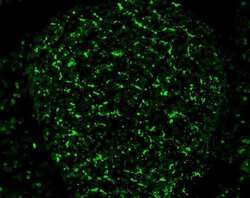
- Experimental details
- Immunofluorescent staining of mouse pancreatic islet cells using Zymed's Rb anti-Connexin 36 (Product # 36-4600).
- Submitted by
- Invitrogen Antibodies (provider)
- Main image
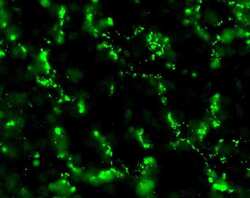
- Experimental details
- Indirect immunofluorescence staining of frozen mouse pancreatic islet cells using Zymed (R) Rb anti-Connexin 36 (Product # 36-4600). Image courtesy of Carl Olson, PhD, and James Nagy, PhD, University of Manitoba, Canada.
- Submitted by
- Invitrogen Antibodies (provider)
- Main image
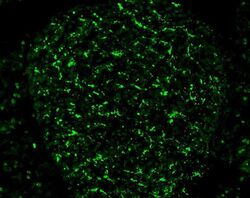
- Experimental details
- Immunofluorescent staining of mouse pancreatic islet cells using Zymed's Rb anti-Connexin 36 (Product # 36-4600).
- Submitted by
- Invitrogen Antibodies (provider)
- Main image
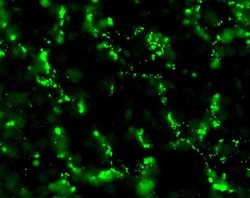
- Experimental details
- Indirect immunofluorescence staining of frozen mouse pancreatic islet cells using Zymed (R) Rb anti-Connexin 36 (Product # 36-4600). Image courtesy of Carl Olson, PhD, and James Nagy, PhD, University of Manitoba, Canada.
Supportive validation
- Submitted by
- Invitrogen Antibodies (provider)
- Main image
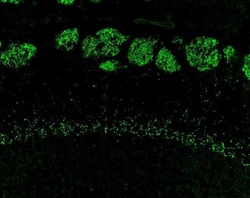
- Experimental details
- Indirect immunofluorescence staining of frozen mouse olfactory bulb using Zymed (R) Rb anti-Connexin 36 (Product # 36-4600). Image courtesy of Carl Olson, PhD, and James Nagy, PhD, University of Manitoba, Canada.
Supportive validation
- Submitted by
- Invitrogen Antibodies (provider)
- Main image
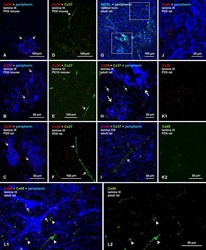
- Experimental details
- NULL
- Submitted by
- Invitrogen Antibodies (provider)
- Main image
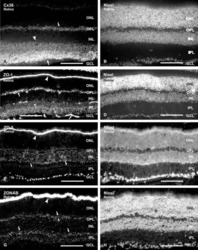
- Experimental details
- NULL
- Submitted by
- Invitrogen Antibodies (provider)
- Main image
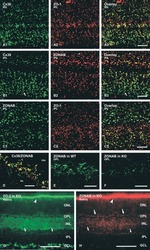
- Experimental details
- NULL
- Submitted by
- Invitrogen Antibodies (provider)
- Main image
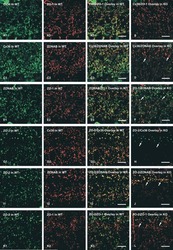
- Experimental details
- NULL
- Submitted by
- Invitrogen Antibodies (provider)
- Main image
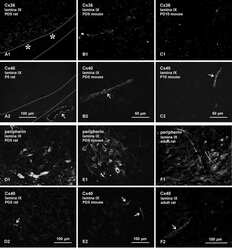
- Experimental details
- NULL
- Submitted by
- Invitrogen Antibodies (provider)
- Main image
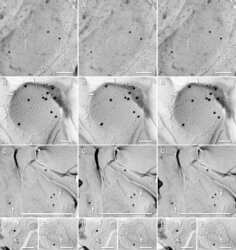
- Experimental details
- NULL
- Submitted by
- Invitrogen Antibodies (provider)
- Main image
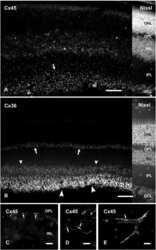
- Experimental details
- NULL
- Submitted by
- Invitrogen Antibodies (provider)
- Main image
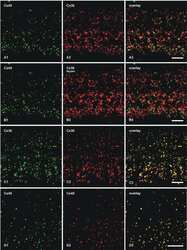
- Experimental details
- NULL
- Submitted by
- Invitrogen Antibodies (provider)
- Main image
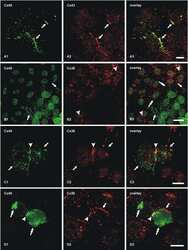
- Experimental details
- NULL
- Submitted by
- Invitrogen Antibodies (provider)
- Main image
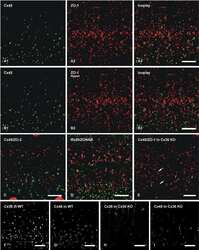
- Experimental details
- NULL
- Submitted by
- Invitrogen Antibodies (provider)
- Main image
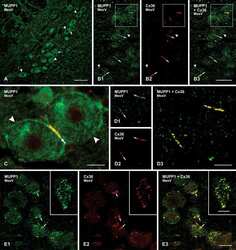
- Experimental details
- NULL
- Submitted by
- Invitrogen Antibodies (provider)
- Main image

- Experimental details
- NULL
- Submitted by
- Invitrogen Antibodies (provider)
- Main image
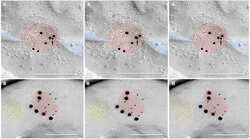
- Experimental details
- NULL
- Submitted by
- Invitrogen Antibodies (provider)
- Main image
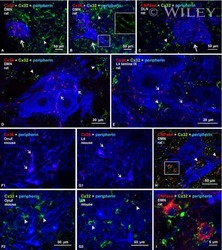
- Experimental details
- NULL
- Submitted by
- Invitrogen Antibodies (provider)
- Main image
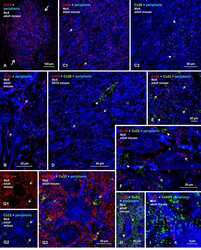
- Experimental details
- NULL
- Submitted by
- Invitrogen Antibodies (provider)
- Main image
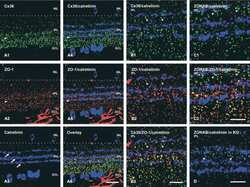
- Experimental details
- NULL
- Submitted by
- Invitrogen Antibodies (provider)
- Main image
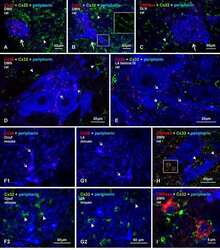
- Experimental details
- NULL
- Submitted by
- Invitrogen Antibodies (provider)
- Main image
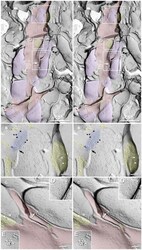
- Experimental details
- Figure 3 Freeze-fracture replica immunogold labeling images of a spiny dendrite in stratum oriens , with gap junction double-labeled for Cx36 (6 and 18-nm gold beads ; within blue overlay ) and cluster of 10-nm E-face IMPs labeled for NR1 glutamate receptor subunits ( 12-nm gold beads within yellow overlays ) . (A) Low magnification stereoscopic images of one of three gap junctions labeled for Cx36 found in a 20 x 20 mum area of stratum oriens . A narrow branched spine [ arrow ; shown at higher magnification as (C) ] is consistent with identification of this neuronal plasma membrane E-face as either a portion of a CA3pyr dendrite (Chicurel and Harris, 1992 ) or of a spiny interneuron. A second branched spine is at the bottom ( red overlay ), separated from the co-planar dendritic shaft by ca. 20 nm, potentially indicating that the two membrane areas were continuous before fracturing. (B) Higher magnification stereoscopic image from (A) showing a medium-diameter gap junction ( blue overlay ) that is postsynaptic to a glutamatergic nerve terminal, identified by the presence of a shared PSD that is immunogold-labeled for NMDA-R1 by five 12-nm gold beads ( arrowheads ). Tilting, rotation, and stereoscopic analysis was required to clearly discern the PSD and gold labels beneath the almost vertical aspect of the replicated PSD in (A) . Note narrowing of the extracellular space ( black arrow ) at edge of gap junction. Air-drying of the high-relief replicas caused compression and art
- Submitted by
- Invitrogen Antibodies (provider)
- Main image
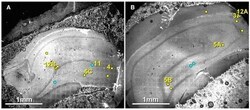
- Experimental details
- Figure 6 Confocal maps showing exact locations of 20 Cx36-immunogold-labeled gap junctions found in adult rat hippocampus . (A,B) The labeled gap junctions shown in Figures 3 , 4 , 5 A-C, 11 , and 12 A,B are indicated by numbered yellow dots . Exact locations of seven other Cx36-labeled gap junctions ( unnumbered yellow dots ) found in these same two replicas are also indicated. In addition, the approximate locations of four other Cx36-labeled gap junctions found in three other replicas are indicated ( unnumbered blue dots ). Note the faint image of the gold ""index""TEM grid beneath and bonded to the tissue slice. Scale bars are 1 mm.
- Submitted by
- Invitrogen Antibodies (provider)
- Main image
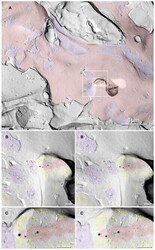
- Experimental details
- Figure 10 Dentate granule cell somatic and proximal dendrite plasma membrane E-face, with immunogold-labeled reticular gap junction . Large area of exposed neuronal plasma membrane ( red overlay ; ca. 1/4 of the 10 mum x 10 mum area is shown) is abutted by multiple large-diameter glutamatergic axon terminals ( purple overlays ). This replica was double-labeled for Cx35 + Cx36. Boxed areas are enlarged as stereoscopic images. (B) At intermediate magnification, active zones (*) are visible in the axon terminal P-face, and clusters of 10-nm E-face IMPs are seen in the subjacent granule cell proximal dendrite E-face, demonstrating two primary components defining multiple chemical synapses. In the center of the image is a two-lobed ""mushroom"" spine that, fortuitously, was shadowed deeply [enlarged as (C) ]. Several active zones (* and purple overlays ), one with a closely-associated PSD ( yellow overlay ), are indicated. A single gold bead above the replica, and therefore representing ""definitive noise,"" is indicated by "" ."" (C) At high-magnification, a medium-size (>150 connexons) ""reticular"" gap junction ( red overlay ) was faintly resolved deep in the spine head, but was easily detected because it is double-labeled by three 18-nm gold beads attached to rabbit polyclonal antibody for Cx35 (fish ortholog of Cx36; O'Brien et al., 2004 , 2006 ) and by 18 6-nm gold beads ( white arrows ) that label mouse monoclonal antibody for Cx36. Glutamate-receptor-like E-face IMPs
- Submitted by
- Invitrogen Antibodies (provider)
- Main image
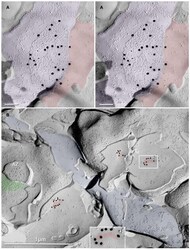
- Experimental details
- Figure 11 Images of freeze-fracture replica of immunogold labeled dendritic gap junctions in hippocampus . (A) Large reticular gap junction found between dendritic shafts of two probable interneurons in stratum oriens . It is labeled for Cx36 by ca. 88 6-nm gold beads and 26 18-nm gold beads. (B) Image of three Cx36-immunogold-labeled gap junctions between unidentified neuronal processes (axon terminals or dendrites). A nearby GABAergic synapse ( green overlay ) is on an unidentified cell process. The adjacent neuronal P-face ( purple overlay ) has the high density of IMPs associated with MF axon varicosities. Green overlay = GABA receptor 9-nm P-face IMPs. One of the gap junctions ( box ) is enlarged as an inset ( bottom center ). AZ, active zone of putative GABAergic synapse. Scale bars are 0.1 mum, unless otherwise indicated.
- Submitted by
- Invitrogen Antibodies (provider)
- Main image
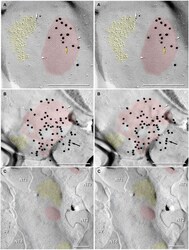
- Experimental details
- Figure 7 Stereoscopic images of large plaque and reticular gap junctions in adult male Mosquitofish. (A) Large plaque gap junction ( red overlay ) on a neuronal postsynaptic E-face labeled with antibodies against mouse/human Cx36 (36-4600, 6-nm [ white arrowheads ] and much more electron-dense 18-nm gold beads) and for GluR2 AMPA receptors (12-nm gold beads, white arrow ) ( Yellow arrow indicates either a 12-nm gold bead as ""noise"" on the Cx36-labeled gap junction or an anomalously small ""18-nm"" gold bead for Cx36). (B) High-magnification stereoscopic image of E-face of a neuronal reticular gap junction ( red overlay ) labeled for Cx35 (P-Ser276) by 6-nm ( white arrowheads ) and 18-nm gold beads. The black arrow points to ""cryptic"" labeling of connexins in an extended portion of the gap junction beneath the cross-fractured neuronal cytoplasm. Immediately adjacent to the gap junction is a cluster of E-face IMPs ( yellow overlay , not labeled) similar to other immunogold-labeled glutamate receptor channels. (C) P-face image showing three of more than a dozen unlabeled postsynaptic hemiplaques ( red overlays ) in the same replica as Figures 4 , 5B , where presynaptic hemiplaques are heavily labeled for Cx35 (P-Ser276). This absence of labeling in C is consistent with our demonstration in goldfish giant club ending/Mauthner cell mixed synapses that Cx35 is exclusively presynaptic and that Cx34.7 is exclusively postsynaptic (Rash et al., 2013 ). The postsynaptic P-face revea
 Explore
Explore Validate
Validate Learn
Learn Western blot
Western blot ELISA
ELISA Immunocytochemistry
Immunocytochemistry